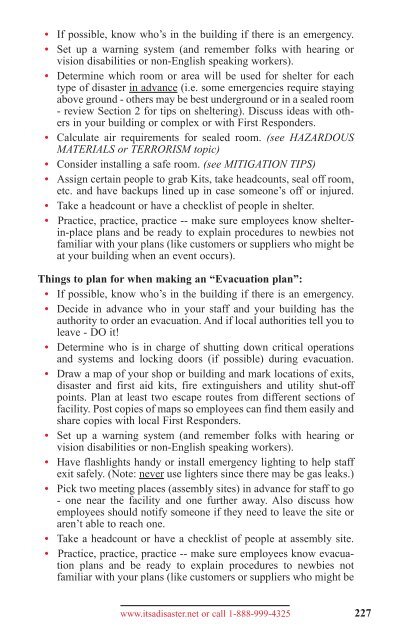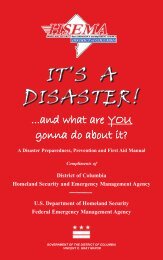disaster 5th 1108_5th ed 2011 - Homeland Security and Emergency ...
disaster 5th 1108_5th ed 2011 - Homeland Security and Emergency ...
disaster 5th 1108_5th ed 2011 - Homeland Security and Emergency ...
Create successful ePaper yourself
Turn your PDF publications into a flip-book with our unique Google optimized e-Paper software.
• If possible, know who’s in the building if there is an emergency.<br />
• Set up a warning system (<strong>and</strong> remember folks with hearing or<br />
vision disabilities or non-English speaking workers).<br />
• Determine which room or area will be us<strong>ed</strong> for shelter for each<br />
type of <strong>disaster</strong> in advance (i.e. some emergencies require staying<br />
above ground - others may be best underground or in a seal<strong>ed</strong> room<br />
- review Section 2 for tips on sheltering). Discuss ideas with others<br />
in your building or complex or with First Responders.<br />
• Calculate air requirements for seal<strong>ed</strong> room. (see HAZARDOUS<br />
MATERIALS or TERRORISM topic)<br />
• Consider installing a safe room. (see MITIGATION TIPS)<br />
• Assign certain people to grab Kits, take headcounts, seal off room,<br />
etc. <strong>and</strong> have backups lin<strong>ed</strong> up in case someone’s off or injur<strong>ed</strong>.<br />
• Take a headcount or have a checklist of people in shelter.<br />
• Practice, practice, practice -- make sure employees know shelterin-place<br />
plans <strong>and</strong> be ready to explain proc<strong>ed</strong>ures to newbies not<br />
familiar with your plans (like customers or suppliers who might be<br />
at your building when an event occurs).<br />
Things to plan for when making an “Evacuation plan”:<br />
• If possible, know who’s in the building if there is an emergency.<br />
• Decide in advance who in your staff <strong>and</strong> your building has the<br />
authority to order an evacuation. And if local authorities tell you to<br />
leave - DO it!<br />
• Determine who is in charge of shutting down critical operations<br />
<strong>and</strong> systems <strong>and</strong> locking doors (if possible) during evacuation.<br />
• Draw a map of your shop or building <strong>and</strong> mark locations of exits,<br />
<strong>disaster</strong> <strong>and</strong> first aid kits, fire extinguishers <strong>and</strong> utility shut-off<br />
points. Plan at least two escape routes from different sections of<br />
facility. Post copies of maps so employees can find them easily <strong>and</strong><br />
share copies with local First Responders.<br />
• Set up a warning system (<strong>and</strong> remember folks with hearing or<br />
vision disabilities or non-English speaking workers).<br />
• Have flashlights h<strong>and</strong>y or install emergency lighting to help staff<br />
exit safely. (Note: never use lighters since there may be gas leaks.)<br />
• Pick two meeting places (assembly sites) in advance for staff to go<br />
- one near the facility <strong>and</strong> one further away. Also discuss how<br />
employees should notify someone if they ne<strong>ed</strong> to leave the site or<br />
aren’t able to reach one.<br />
• Take a headcount or have a checklist of people at assembly site.<br />
• Practice, practice, practice -- make sure employees know evacuation<br />
plans <strong>and</strong> be ready to explain proc<strong>ed</strong>ures to newbies not<br />
familiar with your plans (like customers or suppliers who might be<br />
www.itsa<strong>disaster</strong>.net or call 1-888-999-4325<br />
227





